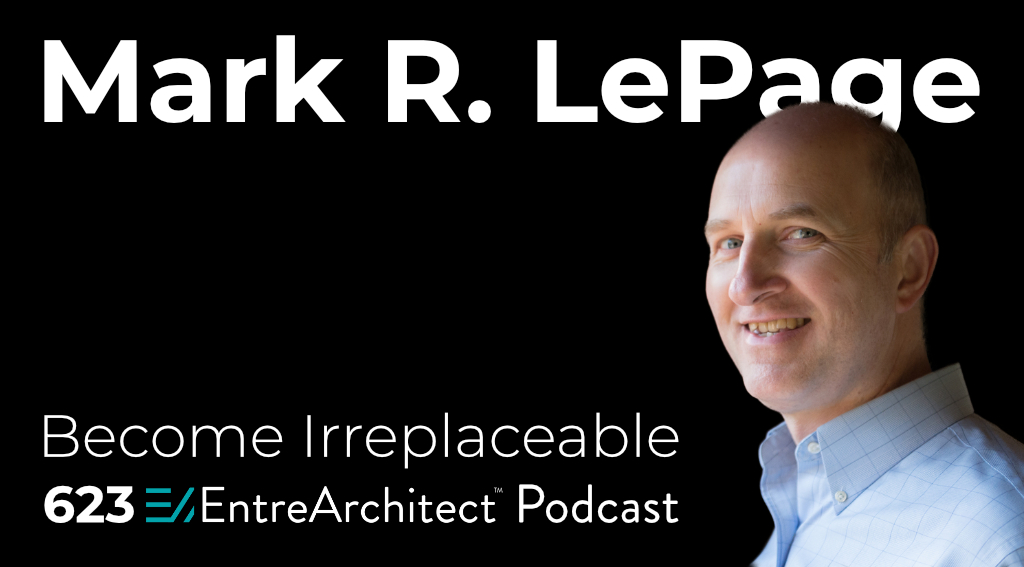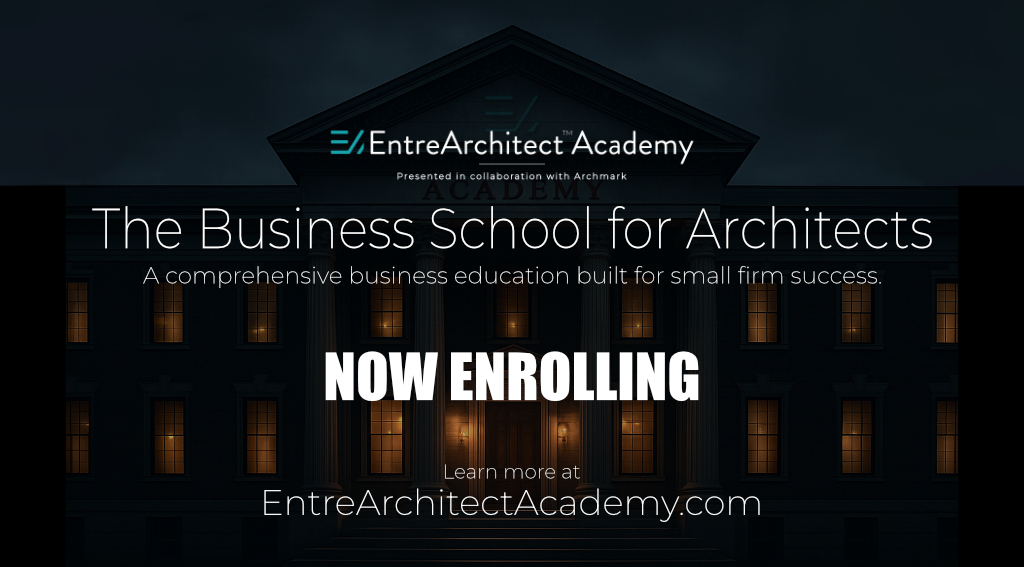
Five commitments to help small firm architects thrive in a world of automation
If you caught last week’s Solo Session, we talked about the shift from trust over task and how the real value of small firm architects lies in human connection, not technical execution. But that left me with a bigger question for this week’s conversation: how do you actually become irreplaceable in a world where AI and automation are advancing faster than we ever imagined?
This is a question that sits heavy on many architects’ minds. We’ve all seen the headlines. New platforms promising one-click design solutions. Drafting tasks being automated with AI tools. Clients who can bypass the architect entirely with online permit packages. The moat of professional protection that once came with our license, software, and training is shrinking.
But here’s what I believe: being irreplaceable has nothing to do with how much you know, and everything to do with how you make people feel.
The truth is, technicians will be replaced. Leaders, guides, and visionaries will not. To thrive in this new era, you must stop competing as a technician and start leading as a trusted partner.
That requires a shift in mindset and a set of deliberate practices. So today, I want to share five commitments that will help you become irreplaceable—no matter what the future throws at us.
Commitment 1: Build Authority, Not Just Portfolio
For decades, architects believed that a portfolio of great work was enough to win clients. “Let the work speak for itself.” That’s the traditional advice. But in today’s world, great design is expected. It’s the minimum standard, not the differentiator.
Authority, on the other hand, is earned. It’s what makes people trust you before they even meet you.
Practical ways to build authority:
- Share your process publicly. Don’t just post pretty pictures of finished projects. Write about how you solved a unique design challenge. Show your sketches and explain your thinking.
- Teach your community. Host a free webinar on a problem homeowners constantly struggle with: zoning, permitting, or energy efficiency. Offer practical advice without asking for anything in return.
- Publish insights consistently. Commit to posting one short article per week on LinkedIn or your firm’s blog. Over time, this builds a body of work that establishes you as the go-to expert.
Think of it this way: every time you publish an idea, you’re making a deposit into your authority bank account. Over time, that account grows into a powerful trust-building engine that no machine can replicate.
Commitment 2: Shift from Deliverables to Outcomes
Too many architects sell drawings. But here’s the hard truth: your drawings are not the product. The real product is the outcome those drawings enable.
A smoother permitting process. A dream home that stays on budget. A school building that inspires learning. A renovation that reduces stress instead of creating it. That’s the value.
Practical ways to shift your focus:
- Reframe your proposals. Instead of listing sheets and deliverables, describe the outcomes your client will experience. For example: “Our process reduces change orders and accelerates approvals.”
- Tell outcome-based stories. When marketing your services, highlight client experiences, not just technical details. “This family moved into their home six weeks ahead of schedule with fewer surprises.”
- Ask outcome-focused questions. In early meetings, ask: “What do you want your life to look like when this project is done?” instead of “How many square feet do you need?”
When you stop selling what you do and start selling what your clients become because of what you do, you elevate yourself from a vendor to a partner.
Commitment 3: Systematize the Low Value, Humanize the High Value
Automation and AI are not your enemy. They’re tools to free up your most valuable resource: time. The key is knowing what to automate and what to amplify with your human touch.
Practical ways to systematize and humanize:
- Systematize repetitive tasks. Use project management software for scheduling, AI tools for drafting, or automated reminders for invoicing. These are not the places to invest your personal energy.
- Reinvest saved time into relationships. Send a handwritten thank-you note at project milestones. Record a short video explaining a design decision so the client feels guided. Pick up the phone for a quick check-in instead of another email.
- Create rituals of care. Maybe you host a quarterly client appreciation lunch or deliver a small “first-day-on-site” gift when construction begins. These gestures humanize the experience and leave lasting impressions.
Clients won’t remember the PDFs. They will remember how you made them feel supported and understood.
Commitment 4: Say No to the Wrong Work
At first glance, this seems counterintuitive. Isn’t being irreplaceable about getting more work, not less? But here’s the reality: saying no to misaligned projects is one of the most powerful things you can do.
Practical ways to say no with confidence:
- Define your ideal client. Write down exactly who you want to serve and what kind of projects bring out your best work. Use this as a filter for new opportunities.
- Create polite scripts for declining. You don’t need to overexplain. A simple: “This project isn’t aligned with our expertise, but I’d be happy to recommend a colleague who can help” preserves goodwill.
- Protect your team’s energy. Misaligned projects often drain time, morale, and resources. Protecting your firm’s capacity for the right work builds long-term resilience.
When you say no to the wrong projects, you create space for the right ones to find you. Irreplaceable architects are not trying to be everything to everyone. They are everything to someone.
Commitment 5: Develop Your Specific Point of View
This is your secret weapon. In a world where machines can mimic technical accuracy, what makes you stand out is your unique lens on the world.
Take the example of my friend James Ray Polk, a longtime member of our community and founder of Music in Architecture. James fuses two worlds—music and architecture—into a practice that speaks in rhythm and harmony. He’s not just selling drawings. He’s offering a symphony of experience that no one else can replicate.
Practical ways to develop your point of view:
- Look beyond architecture. What other passions or disciplines inspire you? Nature, art, history, psychology—these can all inform a unique perspective.
- Articulate your “why.” Write a manifesto for your firm that explains not what you do, but why you do it. Share it openly.
- Be boldly specific. Don’t try to appeal to everyone. Say clearly what you do and what you don’t do. The right clients will be magnetized by your clarity.
Your point of view turns you from one of many into one of a kind. And once clients experience your distinct perspective, you stop competing on price and start being chosen for who you are.
Bringing It All Together
The good news is that everything you need to become irreplaceable is already inside you. It’s not hidden in some expensive AI tool or a new business course. It’s in your story, your empathy, your leadership, and your ability to create human connection.
Stop asking, “How do I compete with AI?” Start asking, “How do I become more fully myself as an architect?”
Here’s a quick recap of the five commitments:
- Build authority, not just portfolio. Share your ideas and insights consistently.
- Shift from deliverables to outcomes. Sell the transformation, not the documents.
- Systematize the low value, humanize the high value. Use technology to free time for connection.
- Say no to the wrong work. Protect your energy for the clients who value you most.
- Develop your specific point of view. Stand boldly in your unique perspective.
Additional Practical Tips
Here are a few more small but powerful practices that support these commitments:
- Block “authority time” on your calendar. Even one hour a week dedicated to publishing or teaching compounds into massive authority over time.
- Use client surveys. After each project, ask what outcomes mattered most to them. Use their language in your marketing.
- Automate without apology. Tools like Zapier, Notion, or AI drafting assistants can save hours. Freeing your time isn’t cheating, it’s leading.
- Track your “no’s.” Keep a simple log of the projects you decline and why. Over time, you’ll sharpen your instincts and refine your ideal client profile.
- Write your firm’s point-of-view statement. Post it where your whole team can see it. This clarity aligns internal culture with external messaging.
Be More Human
No machine can replicate the human connection, empathy, and vision you bring as an architect. The way forward is not to try to outpace technology on its terms, but to lean more fully into what only you can do.
Be bold. Be human. Be irreplaceable.
If this resonates with you and you’d like to continue building a business grounded in these ideas, I invite you to listen to the full episode at EntreArchitect.com/623.

Leave a Reply